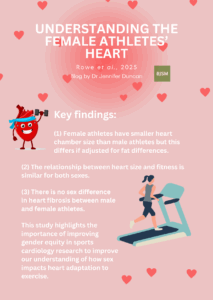Key words: exercise, sex differences, heart
Why is this study important?
This blog is a summary of a recently published BJSM study (1).
The heart of the athlete often demonstrates physical changes as a result of regular endurance training such as bigger chamber or ‘ventricular’ size[2, 3] . However, this phenomenon has predominantly been described in male populations, with female athletes consistently under- represented and assessed only in small cohorts[4-6]. In healthy individuals and athletes, heart chamber size is a known positive predictor of fitness with larger heart size allowing a greater ability for the body to meet the demands of exercise[7]. Sex differences in how the heart adapts to exercise in elite endurance athletes remains unclear. Additionally, previous studies attempting to answer this question have focussed on echocardiographic imaging, whereas cardiac MRI can give more accurate chamber analyses and allows for the assessment of scar in heart muscle.
How did the study go about this?
This international study included over 300 highly trained endurance athletes who had undergone cardiac MRI and gold-standard assessment of cardiorespiratory fitness (using cardiopulmonary exercise testing; VO2peak) (1). We analysed the sex-specific relationships between heart chamber size, function and fitness, as well as assessed for possible differences in scar between male and female athletes. What did the study find?
This study is one of the largest and most comprehensive studies describing the female ‘athlete’s heart’ with cardiac MRI and VO2peak assessment.
Our study derived normative values for heart size in male and female athletes and revealed many key findings:
(1) female athletes have smaller heart chamber size than male athletes but this differs if adjusted for fat differences
(2) the relationship between heart size and fitness is similar for both sexes
(3) there is no sex difference in heart fibrosis between male and female athletes
What are the key take-home points?
Our study highlights the importance of improving gender equity in sports cardiology research to improve our understanding of how sex impacts heart adaptation to exercise. This is important to help differentiate normal from abnormal, as well as helping understand how heart changes may impact health outcomes. In our study, measures of heart structure for female athletes consistently exceeded the ‘normal’ values of the general population, therefore heart size needs to be assessed in the context of fitness.

Blog author: Stephanie Rowe
References
- Rowe S, Janssens K, Mitchell A, et alFemale endurance athletes: smaller hearts but similar relationship between ventricular size, fitness and fibrosis as male athletesBritish Journal of Sports Medicine Published Online First: 29 April 2025. doi: 10.1136/bjsports-2024-109503
- Baggish AL, Wang F, Weiner RB, Elinoff JM, Tournoux F, Boland A, et al. Training-specific changes in cardiac structure and function: a prospective and longitudinal assessment of competitive athletes. J Appl Physiol (1985). 2008;104(4):1121-8.
- Steding K, Engblom H, Buhre T, Carlsson M, Mosen H, Wohlfart B, et al. Relation between cardiac dimensions and peak oxygen uptake. J Cardiovasc Magn Reson. 2010;12(1):8.
- Mitchell A, Janssens K, Howden EJ, La Gerche A, Orchard JJ. Ms-represented: strategies to increase female representation in sports cardiology research. Br J Sports Med. 2024;58(3):122-4.
- Bryde R, Applewhite AI, Abu Dabrh AM, Taylor BJ, Heckman MG, Filmalter SE, et al. Cardiac structure and function in elite female athletes: A systematic review and meta-analysis. Physiol Rep. 2021;9(23):e15141.
- La Gerche A, Wasfy MM, Brosnan MJ, Claessen G, Fatkin D, Heidbuchel H, et al. The Athlete’s Heart-Challenges and Controversies: JACC Focus Seminar 4/4. J Am Coll Cardiol. 2022;80(14):1346-62.
- Rowe S, L’Hoyes W, Milani M, Spencer L, Foulkes S, Paratz E, et al. Left Ventricular Volume as a Predictor of Exercise Capacity and Functional Independence in Individuals with Normal Ejection Fraction. Eur J Prev Cardiol. 2024.